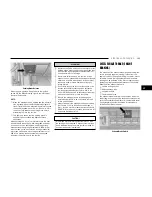
are locked together. This light will illuminate when the
transfer case is shifted into either the 4H or 4L posi-
tion. There is no light for the 2H or N (Neutral) positions
on some models.
When operating your vehicle in 4L, the engine speed is
approximately three times that of the two-wheel drive or 4H
positions at a given road speed. Take care not to over-
speed the engine and do not exceed 25 mph (40 km/h).
Proper operation of four-wheel drive vehicles depends
on tires of equal size, type and circumference on each
wheel. Any difference will adversely affect shifting and
can cause damage to the drivetrain.
NOTE:
Do not attempt to make a shift while only the front or
rear wheels are spinning, as this can cause damage to
driveline components.
Because four-wheel drive provides improved traction,
there is a tendency to exceed safe turning and stopping
speeds. Do not go faster than road conditions permit.
NOTE:
Delayed shifts out of four-wheel drive may be experi-
enced due to uneven tire wear, low or uneven tire pres-
sures, excessive vehicle loading, or cold temperatures.
WARNING!
You or others could be injured or killed if you leave the
vehicle unattended with the transfer case in the N (Neu-
tral) position without first fully engaging the parking
brake. The transfer case N (Neutral) position disengages
both the front and rear drive shafts from the powertrain
and will allow the vehicle to roll, even if the transmission
is in PARK. The parking brake should always be applied
when the driver is not in the vehicle.
Shifting Procedure — Manually Shifted
Transfer Case
2H TO 4H
Shifting between 2H and 4H can be made with the
vehicle stopped or in motion. If the vehicle is in motion,
shifts can be made up to 55 mph (88 km/h). With the
vehicle in motion, the transfer case will engage/
disengage faster if you momentarily release the accel-
erator pedal after completing the shift. Apply a constant
force when shifting the transfer case lever.
2H OR 4H TO 4L
NOTE:
When shifting into or out of 4L some gear noise may be
heard. This noise is normal and is not detrimental to
the vehicle or occupants.
With the vehicle rolling at 2 to 3 mph (3 to 5 km/h),
shift the transmission into NEUTRAL. While the vehicle
is coasting at 2 to 3 mph (3 to 5 km/h), shift the trans-
fer case lever firmly to the desired position. Do not
pause in transfer case Neutral.
NOTE:
•
Pausing in transfer case N (Neutral) in vehicles
equipped with an automatic transmission may
require shutting the engine OFF to avoid gear clash
while completing the shift. If difficulty occurs, shift
the transmission into Neutral, hold your foot on the
brake, and turn the engine OFF. Complete the range
shift to the desired position.
•
Shifting into or out of 4L is possible with the vehicle
completely stopped, however difficulty may occur
due to the mating teeth not being properly aligned.
Several attempts may be required for teeth align-
ment and shift completion to occur. The preferred
method is with the vehicle rolling 2 to 3 mph (3 to
5 km/h). Avoid attempting to engage or disengage
4L with the vehicle moving faster than 2 to 3 mph
(3 to 5 km/h).
•
Do not attempt to shift into or out of 4L while the
transmission is in gear.
Transfer Case Position Indicator Light
The Transfer Case Position Indicator Light in the instru-
ment cluster is used to alert the driver that the front
axle is fully engaged and all four wheels are driving.
LIMITED-SLIP DIFFERENTIAL
The limited-slip differential provides additional traction
on snow, ice, mud, sand and gravel, particularly when
there is a difference between the traction characteris-
tics of the surface under the right and left rear wheels.
During normal driving and cornering, the limited-slip
unit performs similarly to a conventional differential. On
slippery surfaces, however, the differential delivers
more of the driving effort to the rear wheel having the
better traction.
The limited-slip differential is especially helpful during
slippery driving conditions. With both rear wheels on a
slippery surface, a slight application of the accelerator
will supply maximum traction. When starting with only
one rear wheel on an excessively slippery surface,
slight momentary application of the parking brake may
be necessary to gain maximum traction.
STARTING AND OPERATING
123
4
Содержание CHASSIS CAB 2024
Страница 69: ...GETTING TO KNOW YOUR INSTRUMENT PANEL MIDLINE INSTRUMENT CLUSTER GASOLINE 67 3...
Страница 71: ...HIGHLINE INSTRUMENT CLUSTER GASOLINE GETTING TO KNOW YOUR INSTRUMENT PANEL 69 3...
Страница 75: ...MIDLINE INSTRUMENT CLUSTER DIESEL GETTING TO KNOW YOUR INSTRUMENT PANEL 73 3...
Страница 77: ...HIGHLINE INSTRUMENT CLUSTER DIESEL GETTING TO KNOW YOUR INSTRUMENT PANEL 75 3...
Страница 357: ......
Страница 358: ......





































